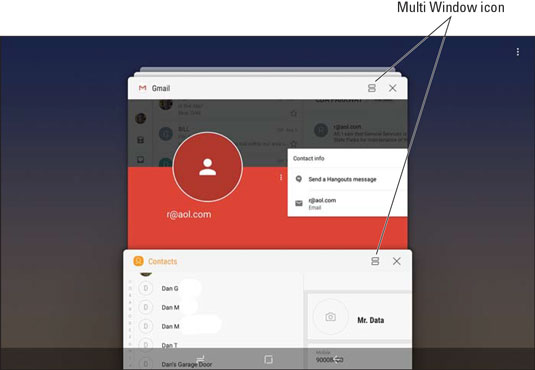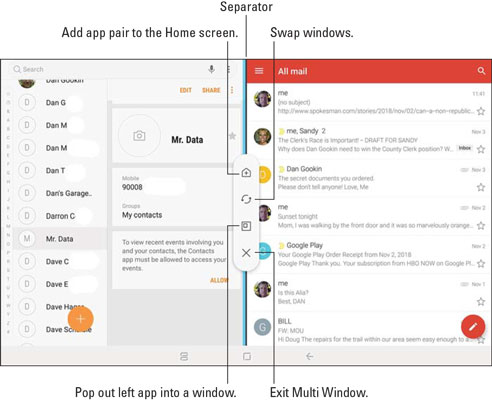Make Some Multi Window Apps Magic
Your Galaxy Tab features a multitasking tool called Multi Window. It allows you to view two apps side-by-side on the touchscreen. This view is opposed to how apps normally run, which is full-screen.
You activate Multi Window from the Overview: To start, tap the Recent navigation icon. Look in the Overview for open apps that feature the Multi Window icon, as illustrated in Figure 24-1. Tap that icon to open the first app, which plops into the leftmost window. The Overview remains in the right window, from which you can choose the second app.
 Finding Multi Window apps in the Overview.
Finding Multi Window apps in the Overview.This figure illustrates two apps running side-by-side with Multi Window active. To use either app, tap in its window. You can scroll each app independently. Long-press the separator between the apps to adjust its position. Tap the center of the separator to see the pop-up.
 Multi Window in action.
Multi Window in action.To exit Multi Window, long-press the separator and tap the Close (X) icon, as illustrated.
- Only certain apps can run in Multi Window.
- Android tablets always run multiple apps at a time. The only benefit to Multi Window is that you can view two apps at the same time.
Snooze with Do Not Disturb Mode on the Samsung Galaxy Tab
I enjoy falling asleep with my Galaxy Tab handy, reading a book or playing a game. When I set it aside, however, I don’t want it to bother me with notification sounds or alerts. Because I can’t control when those items fly in, I activate Do Not Disturb mode. Follow these steps:- Open the Settings app.
- Choose Sounds and Vibration.
- On the right side of the screen, choose Do Not Disturb. You could just slide the master control to the On position, but I recommend instead that you schedule Do Not Disturb mode.
- Choose Turn On As Scheduled.
- Slide the master control to the On position.
- Tap the Set Schedule button to set the hours that you don’t want to be bothered. I prefer 10:00 PM to 6:00 AM (next day).
Do Not Disturb mode mutes any alarms you've set. If you really need to be up by 4 a.m., disable this mode so that you hear the alarm.
Configure Auto Restart on the Samsung Galaxy Tab
You know how they say that you can restart technology to fix some issues? Apparently, Samsung agrees, which is why it offers the Auto Restart feature. When this feature is active, your Tab automatically restarts itself according to a given schedule. Heed these directions:- Open the Settings app.
- Choose General Management.
- On the right side of the screen, choose Reset.
- Choose Auto Restart.
- Slide the master control to the On position.
- Tap the Time and Day items to set when the Tab restarts.
Activate the Blue Light Filter on Samsung Galaxy Tab
The light coming from the Tab’s screen can be garish. In fact, the blue part of the screen’s spectrum could keep you up at night or otherwise disrupt your sleep cycle. To help avoid this condition, you can activate the screen’s Blue Light Filter. Obey these directions:- Open the Settings app.
- Choose Display.
- Choose Blue Light Filter. You can slide the master control to the On position to activate the filter immediately. Otherwise, tapping the Blue Light Filter item lets you set a schedule, which I prefer.
- Choose Turn On as Scheduled.
- If prompted, tap ALLOW to access the device’s location. The location data helps the Tab recognize the time so that the filter can be activated automatically between sundown and sunrise.
- Choose Sunset to Sunrise.

You can instantly activate the Blue Light Filter by choosing the Blue Light Filter item from the Quick Actions shade.
Avoid Display Timeouts with Smart Stay on the Galaxy Tab
Please don’t be frightened, but your Galaxy Tab knows when you’re looking at it. I don’t believe that it actually stares back at you, but it can look for your eyeballs. The advantage is that the display won’t automatically lock as long as you’re looking at the Tab, providing you’ve activated the Smart Stay feature.Laying aside your fears, activate Smart Stay by following these steps:
- Open the Settings app.
- Choose Advanced Features.
- Slide the master control by Smart Stay to the On position.
Watch the Samsung Galaxy Tablet Dream
Does a Galaxy Tab fall asleep when the screen locks? A locked tablet seems rather restrictive, so I prefer to think of the tablet as taking a snooze. But does it dream? Of course it does! You can even see the dreams, if you’ve activated the Screen Saver feature — and if you keep the tablet connected to a power source or in a docking station. Heed these steps:- Open the Settings app.
- Choose Display.
- On the right side of the screen, slide the master control by Screen Saver to the On position. The Daydream feature is activated. Now you choose a daydream type.
- Tap the Screen Saver item to view the various types of daydreams available. I'm fond of Colors.
Some screen saver items feature the Settings icon, which can be used to customize the daydream.
The daydreaming begins when the screen would normally time-out and lock. So, if you set the tablet to lock after 5 minutes of inactivity, it daydreams instead.
- To disrupt the tablet's dreaming, swipe the screen.
- The tablet doesn't lock when it daydreams. To lock the tablet, press the Power Lock button.
Add Spice to Dictation on the Galaxy Tab
I feel that too few people use dictation, despite how handy it can be. Whether or not you use it, you might notice that it occasionally censors some of the words you utter. Perhaps you're the kind of person who won't put up with that kind of s***.Relax, b******. You can lift the vocal censorship ban by following these steps:
- Open the Settings app.
- Choose General.
- On the right side of the screen, tap Language and Input.
- Choose Onscreen Keyboard.
- Choose Google Voice Typing.
- Slide the master control by the option Block Offensive Words to the Off position.
Restore the Samsung Galaxy Tab Apps Icon
The new, Android way to summon the Apps screen is to swipe up the Home screen, from bottom to top. Back in the cave-droid days, Android gizmos such as the Galaxy Tab featured the Apps icon; tap the Apps icon to view the Apps screen. If you want this icon back, follow these steps:- Long-press a blank part of the Home screen.
- Tap the Home Screen Settings icon.
- Choose the Apps Button item.
- Choose the option Show Apps Button.
- Tap the APPLY button. Tap the Home navigation icon to return to the Home screen to see what you’ve wrought.
The Apps icon appears on the far right end of the Home screen dock, looking similar to what’s shown.
Hide the Samsung Galaxy Tab Navigation Bar
The navigation bar is the strip of icons that appears at the bottom of every screen and app on the Tab, illustrated in the following figure. I didn’t even know the bar had a name, but that one dot on the far left bothered me. The navigation bar.
The navigation bar.As it turns out, that dot is used to hide the navigation bar, making it disappear just as it does in some games: Double-tap the dot, and the navigation bar, along with the navigation icons (Recent, Home, Back), disappears! Actually, the bar slides down and out of the way.
To see the navigation bar again, swipe up the screen slightly from the bottom. Double-tap the dot again to lock the navigation bar back into place.
The button to show or hide the navigation bar can be disabled. In the Settings app: Choose Display and tap Navigation Bar on the right side of the screen. Use the master control by the Show and Hide Button item to control whether the button is visible.
Check Your Data Usage on the Galaxy Tab
Whether you have an LTE Tab or a Wi-Fi Tab, you can use the Data Usage screen to check Internet activity and even control how much data is sent and received.To visit the Data Usage screen, heed these steps:
- Open the Settings app.
- Choose Connections.
- On the right side of the screen, choose Data Usage.
- Choose Wi-Fi Data Usage.
The LTE Tab features a category for mobile data usage. You can adjust the red and orange limit bars to set warnings when your mobile data usage gets too close to the monthly limit.






